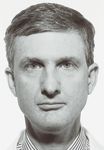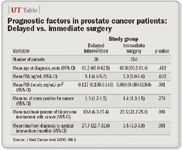Article
Surveillance 'makes sense' in low-grade prostate cancer
Baltimore-Patients with small, lower-grade prostate cancerswho opt to delay surgery are no more likely to progress toincurable disease than are those who choose immediate intervention,say investigators from the Johns Hopkins University School ofMedicine here.

H. Ballentine Carter, MD, professor of urology and oncology at Johns Hopkins, and his colleagues compared a cohort of 38 men who delayed surgery for a median of 26.5 months with a similar group of 150 men who underwent prostatectomies after a median of 3 months. The risk of noncurable prostate cancer was the same for both groups, the researchers reported recently in the Journal of the National Cancer Institute (2006; 98:355-7).
"There is a greater realization now that surveillance makes sense for carefully selected men who are followed," Dr. Carter said.

"This approach is underutilized today in an era in which many men are diagnosed with early, low-risk disease that is not likely to progress during life," Dr. Carter noted.
Patient anxiety and fear that the window of opportunity for cure will be lost lead many men to select immediate treatment, he added. At Johns Hopkins, 2% to 3% of men with prostate cancer choose surveillance, although Dr. Carter estimates that 20% to 30% would be candidates for the expectant management program.
Dr. Carter contrasted expectant management with watchful waiting, which is commonly defined as waiting until progression to metastatic disease before treatment. Watchful waiting has been used in the past on men considered too old or too ill to benefit from treatment or those whose disease was too advanced to cure.
Men in the delayed-treatment arm of the Hopkins study held off surgical intervention for between 12 and 73 months from diagnosis, while those who chose immediate therapy did so from 1 to 9 months later. Noncurable prostate cancer was defined as the presence of adverse pathology associated with less than a 75% chance of remaining disease-free 10 years after surgery.
Nine of 38 men who delayed intervention had noncurable cancer (23%), while 24 of 150 men in the other cohort were diagnosed with it (16%). The relative risk was 1.08 and the 95% confidence interval of noncurable cancer was 0.55 to 2.12 (p=.819), after adjusting for age and PSA density through a Mantel-Haenszel analysis. Age, PSA, and PSA density were significantly associated with the presence of noncurable cancer (p=.030, .013, and .008, respectively).
Men in the study had a median age of 65.4 years, with a range of 48.3 to 77.1 years. Three hundred twenty patients, from which the study subjects were taken, enrolled in the expectant management program at Johns Hopkins between Jan. 1, 1995, and Feb. 1, 2005.
The delayed-intervention arm originally comprised 39 men, but one was excluded for having neoadjuvant androgen deprivation therapy before curative intervention.
Dr. Carter's group is now studying blood and tissue samples from those who developed noncurable cancer to understand the factors that put patients at risk when they are being monitored.
"We are interested in learning more about other tumor markers that may help predict progression and diet and lifestyle factors that may put patients at higher risk of progression," he said.
Dr. Carter is not aware of another study that uses the same selection criteria and that systematically follows patients, although other surveillance programs have used different criteria for enrollment and follow-up, he said.
Newsletter
Stay current with the latest urology news and practice-changing insights — sign up now for the essential updates every urologist needs.















